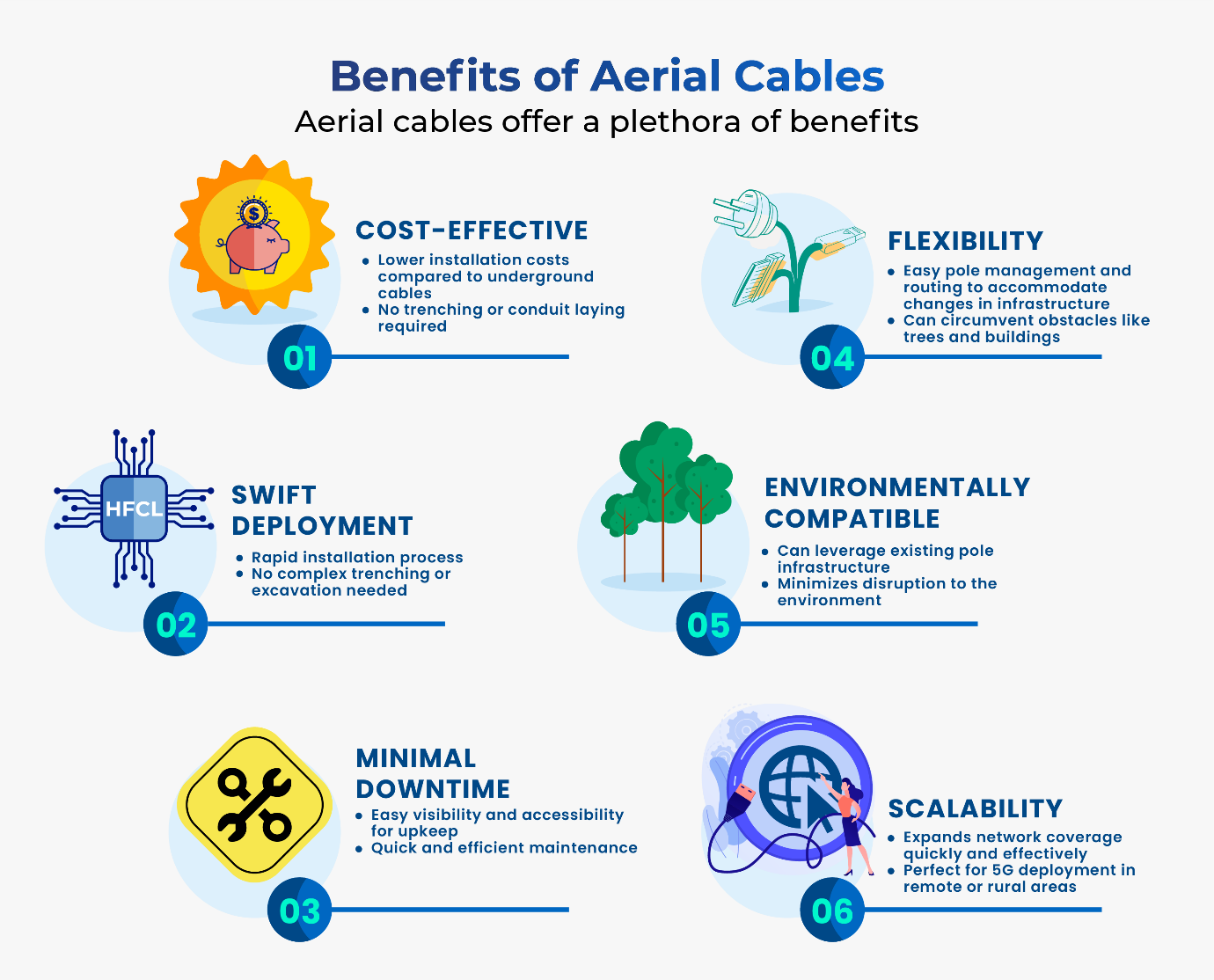Picture this - a bustling metropolis or a tranquil countryside, connected by a network of aerial cables. These cables, carefully strung overhead between poles, serve as the backbone of modern network infrastructure, carrying data across vast distances. These cables ensure a continuous flow of communication, enabling us to stay connected.
Aerial cables, also known as overhead cables, are a crucial component of the modern telecommunications infrastructure. These cables span across vast distances, suspended high above the ground, carrying data and telecommunications signals with high speed and efficiency.
Connecting Horizons: How aerial cables work
In telecommunication applications, infrared light is transmitted through fiber optic aerial cables to facilitate voice and data communications. Fiber optic cables enable data to be transmitted at higher bandwidths and over greater distances as compared to electrical cables.
Aerial cables are required to remain intact and fully operational throughout their lifespan, even as they hang above poles or trees. This demands resilience against mechanical pressures such as the tension caused by their own weight, as well as external forces like wind and ice. These challenges can accelerate the natural aging of these cables.
To address these challenges, aerial cables are meticulously engineered with mechanical strength in mind. They are constructed using a thoughtful selection of materials, including metal strands, aramid (also known as Kevlar) which is renowned for its use in bulletproof vests, and glass-reinforced plastics. These materials are chosen for their durability and adaptability. Advanced manufacturing processes involving sophisticated machinery ensure that these cables not only withstand environmental stresses but also deliver their intended functionalities effectively.
Weather-resistant materials and coatings are also used to protect the cables from environmental elements such as rain, snow, and UV radiation. The dry-band arcing phenomenon ranks among several factors posing a significant threat to the longevity of aerial cables. However, these cables are intricately designed to proactively address such challenges that might arise over their operational lifetime.
Aerial Cables vs Underground Cables:
One might wonder what sets aerial fiber cables apart from their underground counterparts. The distinction lies in their installation method and the unique challenges they face. While underground cables are buried beneath the surface, aerial cables are suspended on poles, towers, or other elevated structures, allowing them to traverse long distances with minimal disruption to the existing environment. This above-ground placement presents both advantages and challenges, making aerial cables a fascinating field of study.
| Factors | Underground Cables | Aerial Cables |
|---|---|---|
| Installation | Buried underground in trenches or conduits | Suspended above ground, typically on poles |
| Visual Impact | Minimal visual impact | May have a more noticeable visual presence |
| Maintenance | More complex to access and repair | Easier access for inspection and maintenance |
| Cost | Generally higher installation cost | Lower installation cost |
| Land Use | Requires land allocation for conduits | Does not consume land space for installation (only requires poles capacity/right of way) |
| Urban Areas | Preferred for densely populated areas | May be used in urban areas but can be visually intrusive |
| Rural Areas | Suitable for rural and remote areas | Commonly used in rural areas |
Benefits of Aerial Cables:

Applications of Aerial Fiber Cables
The significance of aerial fiber cables reaches far beyond their mere presence on poles. They empower businesses, schools, hospitals, and individuals to collaborate, create, and thrive. They open doors to remote work, online education, and telemedicine, transcending geographical barriers and unlocking new possibilities.
Imagine a small-town entrepreneur connecting with clients across borders, a student attending virtual classes from a remote village, or a doctor consulting with specialists from a distant city. All these scenarios are made possible through the seamless connection provided by aerial cables.
Urban Connectivity:
In bustling cities, aerial cables form a vast network, enabling seamless communication and high-speed data transfer. They connect us to mobile networks, internet services, and cable television, making modern life more convenient.
Rural Empowerment:
In remote areas, aerial cables bring connectivity to communities that might otherwise be isolated. They facilitate essential services like telemedicine, allowing patients in far-off regions to access medical consultations and advice from urban healthcare professionals.
Business Connectivity:
Aerial cables play a crucial role in enabling people from rural or remote areas to hone their skills, earn money, and start their journey as entrepreneurs or startup founders. These cables allow businesses to operate efficiently. They support fast data transfer, enabling individuals to communicate with clients and partners worldwide, conduct online transactions, and collaborate in real-time.
Challenges and Innovations
Aerial cables face challenges like weather damage and accidental disruptions. However, continuous research and technological advancements are improving cable materials, installation methods, and durability. Innovations, like reinforced cable designs and protective coatings, ensure that aerial cables can withstand various environmental stressors.
Final Words:
Aerial cables are sturdy cables that connect our world, making communication and connectivity possible. From urban centers to the most remote corners of the globe, these unassuming wires empower us to work, learn, and access vital services. As technology continues to evolve, aerial cables will remain vital in shaping a more connected and accessible world for everyone.